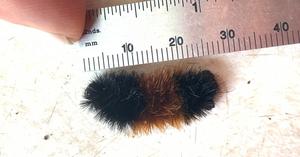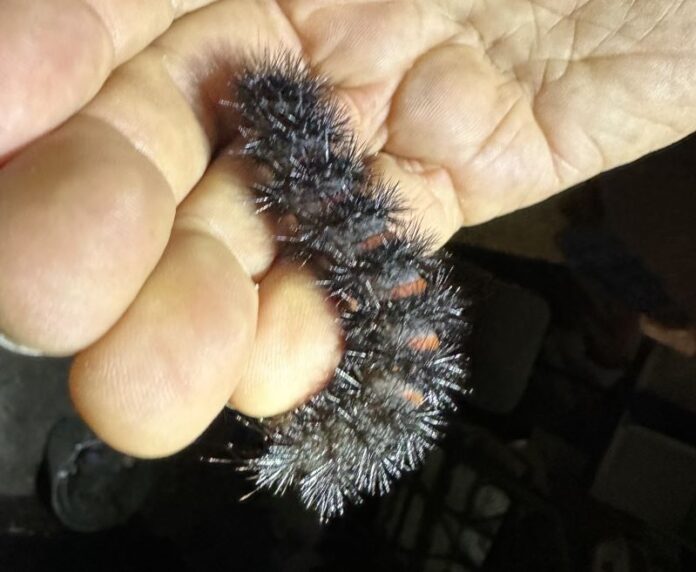by Fred Schueler and Aleta Karstad, Fragile Inheritance natural history
In the fall, hairy black and brown caterpillars cross roads and lawns looking for places to spend the winter. These are the banded “woolly bears” of the Isabella Tiger Moth, Pyrrharctia isabella, which, as adults, have yellowish-orange and cream-colored wings spotted with black. The caterpillars are freeze-tolerant, and pupate and emerge as moths in the spring, after spending the winter super-cooled or frozen in some crack or crevice. Here there’s just one generation each year, but in the Arctic, the caterpillars grow slowly, and are known to freeze over multiple winters.
The predominant folklore associated with these woolly bears is that their colouration predicts the coming winter, with a broader central brown band foretelling a milder winter. Of course, folklore doesn’t suggest how the caterpillar might know about the coming winter, and a gradual widening of the central brown band over the life-stages (instars) of the caterpillars confounds casual observations, but such studies as have been done don’t confirm this idea.

We record when we see woolly bears in our road ecology surveys of the streets of Bishops Mills, and the numbers seen on the streets, from late August through early November, have ranged from none (2004 & 2005) to 50 (2019). So far this year, there have been a dozen on our “doing the streets” transect, and on the afternoon of October 19, one road-killed every fifty metres on 860 m of St Lawrence and Mill streets through the village.
There are a number of other species of hairy caterpillars, but in 2015, when we were surveying road mortality along Hwy 401 between Brockville and Gananoque for the Algonquin to Adirondacks Collaborative, we were astonished to see large black-hairy, red-skinned woolly bears making doomed attempts to cross the highway. These were Giant Leopard Moth (Hypercompe scribonia) caterpillars, apparently at the northern edge of their range in the slightly warmer climate along the St Lawrence River. The adult moths are bright white, spangled with black dots and rings.
With this introduction, and after nearly 40 years of not seeing black woolly bears in Bishops Mills, we saw one here in 2017, 2 in 2018 and 2019, and then 20 sightings (some maybe of the same caterpillars) in 2021, 8 in 2022, and 6 so far in 2023. It turns out that these “caterpillars have a level of freeze tolerance that is adequate for hibernaculum conditions in western Pennsylvania,” but not as great as that of the Isabella Moth woolly bears (Layne & Leszczynski, 2008. Cold Hardiness and Postfreeze Metabolism in Caterpillars of Hypercompe scribonia. Environ. Entomol. 37(5):1069-1073), so we may well be seeing a northward range expansion allowed by the less severe winters of recent years.






